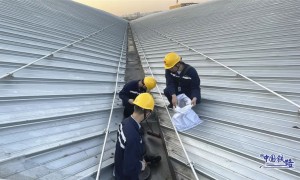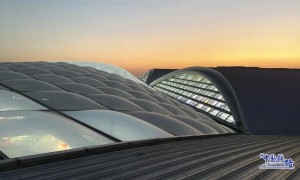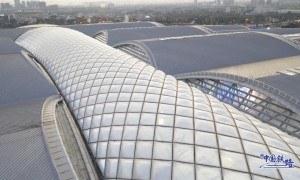说明:本文涉及的技术细节主要针对澳大利亚规范
第一部分 概念
A party wall (occasionally parti-wall or parting wall, also known as common wall) is a dividing partition between two adjoining buildings that is shared by the occupants of each residence or business. Typically, the builder lays the wall along a property line dividing two terraced houses, so that one half of the wall’s thickness lies on each side. This type of wall is usually structural. Party walls can also be formed by two abutting walls built at different times. The term can be also used to describe a division between separate units within a multi-unit apartment complex. Very often the wall in this case is non-structural but designed to meet established criteria for sound and/or fire protection, i.e. a firewall.
英国
While party walls are effectively in common ownership of two or more immediately adjacent owners, there are various possibilities for legal ownership: the wall may belong to both tenants (in common), to one tenant or the other, or partly to one, partly to the other. In cases where the ownership is not shared, both parties have use of the wall, if not ownership. Other party structures can exist, such as floors dividing flats or apartments.
A part from special statutory definitions, the term “Party Wall” may be used in four different legal senses.It may mean:
1 a wall of which the adjoining owners are tenants in common;
2 a wall divided longitudinally into two strips, one belonging to each of the neighbouring owners;
3 a wall which belongs entirely to one of the adjoining owners, but is subject to an easement or right in the other to have it maintained as a dividing wall between the two tenements;
4 a wall divided longitudinally into two moieties, each moiety being subject to a cross easement, in favour of the owner of the other moiety.
In English law the party wall does not confirm a boundary at its median point and there are instances where the legal boundary between adjoining lands actually comes at one face or the other of a wall or part of it, and sometimes at some odd measurement within the thickness of the wall. The legal position is, however, clear insofar as a party using or benefiting from a party wall or structure abutting, on or in its land has rights to use the wall and for it to be retained should the other side no longer wish it to be there. For this reason, expert surveyors are used in the main to issue notices, deal with the response from someone receiving a notice and settling any dispute by an Award. Details can be obtained from the Royal Institution of Chartered Surveyors.
Originating in London as early as the 11th century, requirements for terraced houses to have a dividing wall substantially capable of acting as a fire break have been applied in some form or other. Evidently, this was not enough to prevent the several great fires of London, and the most famous of which being the Great Fire of 1666.
In England and Wales, the Party Wall etc. Act 1996, to afford rights on the owners of party walls, other party structures, and other matters affecting adjoining structures.
巴黎
The principles of the party wall in Paris under the common law in 1765 are the following:
1 If a man when building his home does not leave a sufficient space on his property he can not prevent his wall becoming a party wall with his neighbor who could build his home erect to the wall paying half the cost for materials and land that the wall resides on.
2 Nothing can be done to the party wall without legal consent of both neighboring parties.
3 Repairs to the wall are split equally between the two neighboring parties.
4 No beams (of a home) can be placed in the walls by either party more than a one-half inch the thickness of the wall. If a party does wish to install beams into the wall greater than one-half inch thickness of the wall then materials such as jams, or chains must also be added in order to support the beams.
美国
In the USA, the term may refer to a fire wall that separates and is used in common by two adjoining buildings (condominium, row house), or the wall between two adjacent commercial buildings that were often built using common walls, or built walls onto existing walls. Rights and obligations are governed by state statutes, and common law.
The wall starts at the foundation and continues up to a parapet, creating two separate and structurally independent buildings on either side.
(以上内容来源维基百科)
澳大利亚
What is a party wall?
A party wall (also sometimes known as a partiwall), is a wall that is shared between two or more residents of individual dwellings. A ceiling that is also the underside of the floor of a separate upstairs home can be considered a party wall.
What is a party wall for?
Town houses, terraces and apartments are often divided into separate dwellings by a party wall. A party wall creates a barrier between two or more adjoining homes, preventing the transmission of sound, temperature and fire between them.
How are party walls constructed?
Australian building regulations now have requirements for the minimum thickness and insulatory properties of party walls. A party wall in a standard timber framed house is generally built with a double width frame. The extra space creates room for more effective soundproofing and thermalinsulation. A fire barrier is usually placed in between the double frame, which is typically finished with plasterboard on either side. Party walls in older homes might be thinner and made from materials such as brick or a single thickness of lath and plaster.
Renovations and regulations
Party walls are a common source of problems between neighbours.A wall may be solely owned by one resident or ownership may be split equally between the two. Even if you are the rightful owner of a party wall though, you may not commence any large scale work or renovations on the wall without first gaining consent from the from the building owner on the other side of the wall.Sound is another breeding ground for neighbourly disputes. Even with heavy insulation, sound can travel between shared walls and down from ceilings.Normal living sounds can be amplified and even seem intentional at times (never put your bed next to a party wall!). Any dispute with a neighbour should be approached in a calm and friendly manner – remember you share your living space with these people!
第二部分 NCC中关于party wall的一些规定
The increase in multi-residential development in Australia over the past decade, and the projected future growth in this sector places greater needs on developers, architects, building designers and builders to ensure that they’re selecting appropriate fire safety solutions. Critical to better fire safety in particular is the selection of a party wall solution that suits both the technical and design parameters of the project.
A poor selection for the party wallsolution may lead to, at best, an unnecessarily expensive construction optionor complex site rectification if the non-compliance is found before completion;and in the worst case, non-compliant and potentially quite dangerous construction.
To achieve best practice out comes for compliant party wall systems, a balance of three key objectives is required.These include:
Design considerations – Ensuring that the chosen party wall system takes into account the varied design considerations relevant to the project. These may include the class of construction, the land title, and the style of the design.
Compliance – The need to comply with official requirements of legislation, or the demand of interested parties to the construction process.
Buildability – Which could be considered the process of integrating the ‘thinking’ and the ‘doing’ – or looking at a design from the perspective of those that will manufacture, install components and carry out the construction works.
The fire safety objective of party walls in Class 1 and 10a buildings is addressed in Volume 2 of the National Construction Code (NCC), and generally the requirements are to:
– safeguard the occupants from illness or injury by alerting them of a fire in the building so that they may safely evacuate, and
– avoid the spread of fire from one building to another.
For sole occupancy units in constructionclasses including Class 2 and 3 buildings, the fire safety objective of party walls (other wise known as inter-tenancy walls) is addressed in Volume 1 of theNCC. The general requirements for these buildings are to:
– safeguard people from illness or injury due to a fire in a building,
– safeguard occupants from illness or injury while evacuating a building duringa fire,
– facilitate the activities of emergency services personnel,
– avoid the spread of fire between buildings, and
– protect other property from physical damage caused by structural failure of a building as a result of fire.
In large scale buildings, meeting these requirements is assisted by dividing the building into compartments, which helps to ensure that occupants can be evacuated within an acceptable timeframe.
Sound insulation between dwellings is similarly covered within the NCC – in Volume 2 for Class 1 and 10a buildings,and Volume 1 for Class 2, 3, 4 and 9a buildings. The objectives are actually similar, in that walls separating dwellings must provide insulation against the transmission of airborne sound, sufficiently to prevent illness or loss of amenity for the occupants. For larger scale buildings, sound generated by plant and equipment also needs to be addressed to make sure there’s no additional loss of amenity.
It’s common experience that small scale projects are often less prepared in consideration of these objectives. That’s often down to the inadequate prior consultation to develop a fire safety concept, but more often it’s due to planning changes imposed by local authorities during the development application (DA) process, without consideration for fire safety.
In larger projects, the scale and complexity of the fire safety solution, as well as the need for consistency in detailing throughout the design and construction of the building, combined with the lack of understanding across the trades is often the culprit when it comes to non-compliance. A better understanding of the need for fire safety ingeneral and methods to achieve compliance is certainly required.
Design considerations
Integration of fire safety – including the party wall systems – at the early design stages is critical to ensuring both adequate fire protection for the building’s occupants, and ensuring that the required design outcomes are achieved.
The first issue for consideration is the influence the property title has over the method of fire protection. Whether the development is subdivided under Torrens Title or Strata Title will influence the definition of the property boundary under the NCC, and in turn that may have an effect on the fire protection required for external walls.
For example, where adjoining townhouses(Class 1a) are built under Torrens Title with the currently popular skillion roof design. This involves a single roof falling across the whole property with an overhang each side – and is likely not to comply with the NCC, as it requires a building to be built wholly within its boundaries. If a similar design is built under Strata Title though, the party wall is not determined to be the boundary – but it will still require a fire safety solution.
Some of the most complex solutions are required to comply with the simplest requirements – including, for example, how to respond to eaves overhangs which are common to more than one dwelling, and the requirement to provide separation within the eaves space with non-combustible vertical lining. The successful implementation of this requirement requires the separation of roof framing to ensure that should one dwelling collapse due to fire, it won’t affect the neighbouring dwelling.
There are a number of commonly available party wall systems which provide compliant party walls in accordance with the NCC. These include:
– masonry walls of either brickwork or blockwork with a minimum thickness of 90mm as defined under the Deemed-to-Satisfy (DTS) Provisions of the NCC,
– proprietary masonry walls systems assessed by a Registered Testing Authority(RTA) to meet the DTS Provisions of the NCC,
– proprietary lightweight walls systems assessed by a Registered Testing Authority (RTA) to meet the DTS Provisions of the NCC.
As the construction industry is steadily seeking to reduce the number of trades on construction sites, light weight wall solutions are becoming more derigueur than traditional masonry systems.
Commonly available lightweight party walls systems include:
– double stud timber framing with fire rated plasterboard on the internal linings,
– double stud timber or steel framing with an inner fire rated Shaft liner with non-fire rated internal linings,
– staged wall solutions which allow progressive construction of attached dwellings by offering initial protection of the – – external wall from the outside only, which then, when built side-by-side, provide a compliant party wall system.
Lightweight wall options are proprietary solutions and require compliance with the installation requirements of the manufacturer. Where necessary, consultation with the manufacturer is highly recommended at the design stage.
Compliance with codes and Standards
Compliance with the NCC and the Australian Standards referenced within the NCC is absolutely mandatory. There are three paths to compliance:
– meeting the Performance Requirements by complying with the Deemed-to-Satisfy Provisions
– formulating an Alternative Solution by meeting the Objectives and Functional Statements within the required clauses of the NCC, or
– a combination of the two paths.
Party wall construction typically requires compliance with three Standards. These include:
– Fire Resistance Levels (FRL),
– achieving adequate acoustic separation, and where required
– maintaining discontinuous construction.
For Class 1 and 10 buildings, the key technical requirements under the Deemed-to-Satisfy Provisions within Volume 2 of the NCC are:
the need to maintain a 20mm minimum cavity to achieve discontinuous construction between a bathroom, sanitary compartment,laundry or kitchen and a habitable room (other than a kitchen) in accordance with Table 3.8.6.1 of the NCC,
achieving an acoustic resistance of Rw+Ctr 50 between dwellings and a Rw+Ctr of between 25 and 40 for a duct, soil waste, water supply pipe or storm water pipe that passes through a separating wall in accordance with Table 3.8.6.1 of the NCC, and
achieving a FRL of 60/60/60 (from bothsides) for Separating Walls which commence at the footings or ground slab and extend to the underside of a non-combustible roof, or not less that 450mm above a combustible roof covering.
External walls which are less than 900mm from an allotment boundary, other than the boundary adjoining a road or other public space, or 1.8m from another building on the same allotment are requiredto have an FRL of not less than 60/60/60 when tested from the outside in accordance with Clause 3.7.1.5 of the NCC.
For Class 2 and 3 buildings the key technical requirements under the Deemed-to-Satisfy Provisions within Volume 1 of the NCC are:
– the need to maintain a 20mm minimum cavity to achieve discontinuous construction if it separates a bathroom,sanitary compartment, laundry or kitchen in one sole-occupancy unit from a habitable room (other than a kitchen) in an adjoining unit; or a sole-occupancy unit from a plant room or lift shaft in accordance with Clause F5.5(a) of theNCC,
– achieving an acoustic resistance of Rw+Ctr 50, if it separates sole occupancy units; and have an Rw 50, if it separates a sole occupancy unit from a plantroom, lift shaft, stairway, public corridor, public lobby or the like, or parts of a building with a different classification in accordance with Clause F5.5(a)of the NCC,
– achieving a FRL of -/60/60 for non load bearing walls and 90/90/90 for loadbearing walls (from both sides) between or bounding sole occupancy units inaccordance with Specification C1.1 of the NCC.
External walls of Class 2 and 3 buildings may be required to have an FRL when tested from the outside, depending on theproximity of a fire source in accordance with Specification C1.1 of the NCC.
In Torrens Title developments,consideration may be required to implement a legal covenant on the party wall,placing limitations or restrictions on the allowable use of the party wall to maintain the performance of the wall system.
In Strata Title developments the party wall part of the Strata is managed by the Strata Manager and limitations are typically in place to limit modification of the wall.
The ongoing use of the building may also affect compliance, as the maintenance of the FRL for the party wall is critical to ensure that occupants are protected if there’s a fire. The simple case of a home owner adding power outlets, or fixing a flat screen television to a party wall may breach the fire resistance of the party wall.
Ensuring buildability
The scale of the project (along with the preferred construction system) has a significant influence on the ‘buildability’ of the project, in the following ways:
– Lightweight steel framed structures are typically limited to Class 1a buildings where each dwelling is separated by a fire rated wall.
– Lightweight timber framed structures are typically limited to three storey constructions, and may require a combined consideration of the ‘char effect’ of the timber and protection from fire rated plasterboard to achieve adequate firesafety for both walls and ceilings.
– Medium rise timber structures built using newer technologies (including Cross Laminated Timber (CLT)) are possible, but require that a solution to fire safety be formulated as an Alternative Solution under the NCC.
– Medium to high rise masonry structures offer the opportunity for fit-out in lightweight steel framed and fire rated plasterboard lined walls between floorslabs.
– Careful consideration is required at the roof level of major projects where the preferred structural solution is heavy gauge structural steel, asunprotected structural steel framing penetrating a fire wall reduces its fireperformance.
More recently, the industry has had toadapt to conditions imposed by lenders on the finance offered to those seeking it for off-the-plan purchases. These conditions require the separation of dwellings which were historically ‘attached’. The implication is that if the construction of one dwelling should be delayed, the adjacent dwelling will:
– comply with the NCC for zero-lot construction, in that it’s fire rated from outside only,
– while exposed, protect the constructed dwelling from exposure to weather.
When combined, the ‘external walls’ of zero lot construction must revert back so that they comply with the technical requirements of the NCC for party walls.
‘Zero lot’ construction refers to the situation you get when a building is built up against a boundary, and is therefore required to have an FRL to protect the building from neighbouring building fires.
In many cases, buildings are built up to an existing building and can’t be constructed from outside of the building envelope. In these cases, analysis of the ‘buildability’ of the project may require a tilt-up style modular construction process, which can be built in components, either on-site or off-site in a factory, delivered to the site and lifted into position.
Maintaining the FRL of the wall system is critical, and will require processes which have been reviewed in a Fire Assessment prepared by an RTA.
Small scale projects – which often have reduced financial capacity – often lack input from specialised fire and acoustic consultants, and are frequently those where issues surrounding compliance with party wall requirements arise.
In some circumstances, these problems are the result of planning decisions that have led to amended designs with unresolved construction methods. Where these issues can’t be resolved with proprietary solutions, they will require input from a fire engineer to consider whether an Alternative Solution is available.
第三部分 可耐福/gpyrock(石膏板)方案
一般的,在澳大利亚进行产品选型,应首先确定房屋的等级。下面这个技术手册适用于class 1等级的建筑物。
第四部分 哈迪板(水泥纤维板)方案
第五部分 HEBEL(AAC)方案
第六部分 施工实景图片
第七部分 防火密缝/隔离








